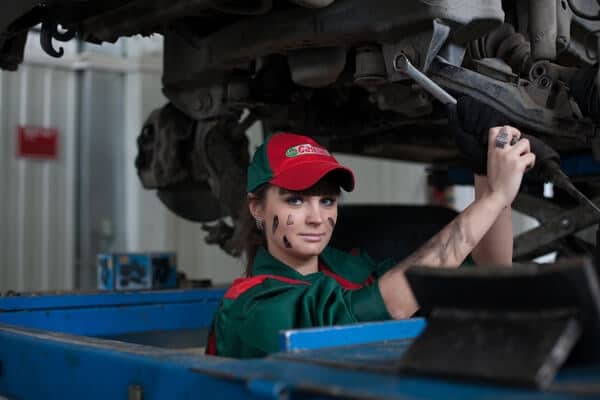Keep your car running and safe while keeping repair costs down
We’re not all gearheads. Sure, we may love our cars, but for many of us, if it gets us from point A to point B and looks OK doing it, we’re good. But when there’s a noise or a light on your dashboard, it raises concerns over what kind of repairs are needed when your car starts to show its age.
That’s why we’ve put together some advice to help you get the most out of your vehicle. Follow these simple steps that can help keep your car safe on the road, and possibly avoid costly maintenance.
Repair costs fluctuate based on the make and model
When choosing a car, you might get excited about that stylish import—especially if it comes at a decent price for a used (pre-owned) vehicle. But understand it might come with heftier costs for repairs and maintenance. There’s no one-size-fits-all cost for repairs, it’s all relative to the vehicle you’re purchasing. If you buy a $10,000 car; the maintenance costs are going to be different than if you buy a $70,000 car.
Find a reputable repair shop
If you don’t know much about how your car works, or what the difference is between a serpentine belt and a brake caliper, it’s only natural for you to be wary of repair shops. You might find it difficult to trust someone when they’re talking about things you just don’t understand. That’s OK.
Ask around to find a place you’ll be comfortable with. That way, you can build a relationship with a reputable repair shop you trust.
When you find a garage, the first thing you’ll want to establish is a regular inspection every year. By being proactive, you’ll likely end up saving money in the end. Some garages do a courtesy check—a free inspection that looks at upwards of 50 inspection points on your vehicle. If you don’t know much about a car, that quality control inspection will tell you what repairs your car needs.
Understand the maintenance schedule
Whether it’s a new car or a pre-owned car, take some time to get familiar with it. You may not understand every nook and cranny, but it’s a complex machine and you need to plan how you’re going to care for it.
Checking the manual is an important first step. Every car manual has recommendations for maintenance schedules and the things you should do based on the mileage and age of the vehicle. Get to know the schedule so you can make a plan with your repair shop to keep things in good working order. When the car is in the shop for its oil change, which should be every 3,000–5,000 miles, you should have an inspection done to learn about repair issues that require your attention.
Gas maintenance
As for fuel, each car has a recommended octane rating for the gas it burns. That information should be in your car’s manual. Some cars also have it listed on the label inside the gas cap. It’s important to not let your gas tank get too low, since the fuel helps balance the temperatures in your fuel pump. Having enough gas is also a safety measure. After all, you don’t want to get stuck somewhere—especially in the winter months. When it comes to having a full tank of gas, it’s better to be safe than sorry.
Be mindful of your battery
No one wants their battery to die at night, in the middle of winter, or in the middle of nowhere. You might think you’ll have no idea when your battery will reach the end, but like many of the other vital components of your car, it can be planned for—and it might help you avoid a costly towing charge. Typical car batteries last four to five years. If you have a 2012 car and you’re still on the original battery in 2019, it’s time to think about that new battery before you get stuck somewhere. Your repair shop should test the level of your battery, and alert you when that battery is five years old and in need of replacement. If they don’t, be sure to ask.
Change your wipers every six months
Good wiper blades are essential to being able to safely see through your windshield. When the blade’s rubber starts degrading, it won’t properly clean your windshield. That little rubber strip has moisture in it, and when it dries out with use and age, it skips across the windshield, leaving streaks that obscure your vision. You should replace your wiper blades about every six months.
What you should know about your tires
Tires are a big, expensive purchase. They’re also incredibly important for your car’s safety and performance. To avoid a big hit on your wallet, experts recommend you plan for a new set of tires a couple of months ahead of time, so you’re ready when you need to purchase them. Regular car inspections at your repair shop should keep you informed about your tire condition.
In the meantime, you’ll want to keep an eye on tire pressure and treads. The required pressure for your car’s tires’ should be listed on a sticker on your car’s door. Remember that cold weather can deflate your tires, so keep an eye on them during extreme temperature drops.
If you’re unsure about your tires’ tread quality, take a penny and put it in the tread upside down, facing you. If the head doesn’t disappear into the tread, it’s time for new tires. Two millimeters is the minimal amount of depth you’d ever want to have on a tire.
Warming up your car in winter is important
This one’s basic if you live in colder areas. Warming up the car for a few minutes before you start driving helps clear your windows and warms up the fluids your car needs to keep all of its mechanical components working correctly. When your car is warmed up, you’ll avoid that herky-jerky motion you experience in bitter cold when your car isn’t ready to go. Use the warm-up time to clear your windows of snow and ice so you can see, and don’t forget to clean off the roof. Drivers often overlook clearing the snow from the roof, hood, or back of their car. Those chunks of snow and ice can easily fly off and hit other drivers, leading to dangerous accidents and even broken windows.
A clean car improves safety and can keep maintenance costs in check
A car wash isn’t all about vanity. It helps fight off corrosive substances and keeps your windows clean. Cold, ice, snow, and salt used on roads in winter can be corrosive to your car. When the temperatures in winter warm up a little, you should wash your vehicle to help keep salt off of the body and the underside of the car. Leaving the salt on can lead to rust and metal breakdown on your car. In addition, if you’re not getting a regular car wash, your windows might be too dirty to let you safely see while driving, especially at night or when the sun is low.
By following these simple tips, you’ll not only help extend the life of your vehicle, but you’ll also be rewarded with a safer ride down the road.
Originally Published on Dairyland Blogs On December 16, 2019





